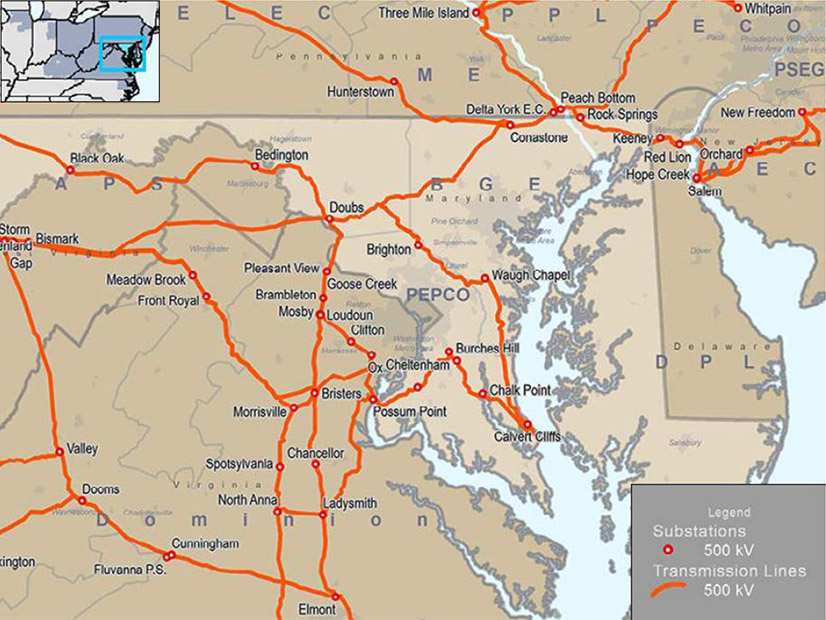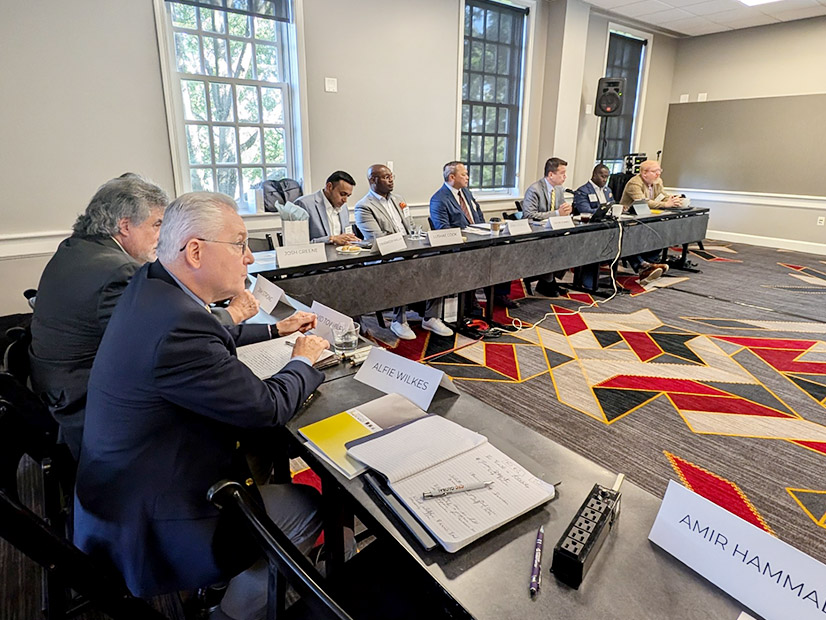
COLLEGE PARK, Md. ― Maryland consumes five times more energy than it generates, has limited access to transmission in the central and eastern parts of the state and at present has only six projects totaling 1,245 MW in PJM’s interconnection queue.
“Maryland, as many of you know, has been a state where transmission has come to die,” said Jason Stanek, executive director of governmental services at PJM, in his opening remarks as moderator for a grid reliability roundtable at the Maryland Clean Energy Summit on Oct. 7.
A former chair of the Maryland Public Service Commission, Stanek provided an overview of the state’s dilemma as it seeks to cut its greenhouse gas emissions 60% below 2006 levels by 2031 and decarbonize its power grid by 2035, all while attracting new business, including megawatt-guzzling data centers.
PJM estimates data centers will grow from 4% of Maryland’s power demand in 2024 to 12% in 2029 and 16% in 2039, but Stanek cautioned those numbers could be conservative, and the RTO revises the projections every year. Since 2018, new generation coming online in Maryland has been outpaced by retirements, with 1,600 MW coming online versus 6,000 MW coming off, he said.
“Last year, Maryland held an unenviable position of needing to import [power] every single hour of every single day,” he said.
Facing each other across tables running along three sides of the meeting room, participants ranged from state lawmakers to offshore wind developers and other industry experts, each with different perspectives on the state’s challenges and possible solutions, both short and long term.
Del. Lorig Charkoudian (D) talked up a bill she hopes to introduce in Maryland’s General Assembly in January, aimed at accelerating the permitting process for energy storage and other distributed energy resources coming onto Maryland’s distribution system, outside of PJM’s jurisdiction.
“I think that PJM doesn’t do the job it needs to be doing on transmission planning, and I think that our hands are tied, and so … I have finally just given up and put [planning provisions] into this bill,” Charkoudian said.
An outline of the bill is being circulated for input from stakeholders but has been informally dubbed “Build Stuff in Maryland,” she said. “The idea is, what can we do fastest? And the thing we can do fastest is distribution utilities can put storage on the distribution grid; so, medium size … 1,2,3 MW at substations, and that can be done at a pretty quick scale to respond to some of the immediate [reliability] problems, assuming storage is treated fairly in capacity markets.”
While not on the bulk transmission system, these projects could “address our resource adequacy problems fairly quickly,” she said.
Stanek and others pointed to FERC’s recently passed Order 1920, which aims to provide a new, more comprehensive framework for RTO and ISO transmission planning, for example, calling on the grid operators to consider grid-enhancing technologies, such as advanced conductors, that can increase capacity on existing lines.
David Townley, public policy director at CTC Global, an advanced conductor manufacturer, argued that waiting for much-needed transmission to be built can take years, triggering additional risks as new generation comes online. “By the time you get the line built, you may be in a congestion point; it may not be the solution anymore,” Townley said. “Take steps you can take now to open up those capacities … because the lines are loading up and changing.”
Abe Silverman, assistant research scholar at the Ralph O’Connor Sustainable Energy Institute at Johns Hopkins University, cautioned that full implementation of 1920 is still five years away but that states now should be codifying their goals and policies for clean energy and grid planning.
“That will help a lot,” said Silverman, who previously was general counsel and executive policy counsel for the New Jersey Board of Public Utilities (BPU). “So, the more you can put on paper and hand to PJM [and] say, ‘These are our goals,’ the stronger that 1920 planning process will be.”
States like Maryland should encourage their neighbors in the PJM service territory to “codify their rules in a comparable manner.” Then they present PJM with a “comprehensive action plan” as part of the 1920 process, he said.
State of the Grid
Stanek was quizzed on PJM’s request to FERC for a rehearing of 1920, one of many the commission has received and is considering.
PJM found the 1,363-page ruling “overly restrictive for a footprint as diverse and wide, serving 65 million customers,” he said. “So, the purpose of the request for rehearing was to preserve our right to inform FERC that we think there should be more flexibility in how PJM complies” with the rule.
“Otherwise, this final rule is effectively one-size-fits-all,” Stanek said. At the same time, PJM is moving ahead to comply with the timelines set out in the rule, he said.
Stanek’s opening presentation zeroed in on the key challenges for transmission planning in Maryland.
The state’s generation mix is 42.8% natural gas and 42.9% nuclear, with coal and hydro providing about 5% each, and wind and “other” accounting for a final 4.3%.
But what’s in PJM’s interconnection queue for the state is 54% energy storage, 44% solar, 1% wind and less than 1% natural gas and hydro.
The state is one of a handful that does not have an overarching, holistic plan for infrastructure development to help guide the transition to clean energy ― as opposed to the GHG emission reduction plan the Maryland Department of the Environment issued at the end of 2023 ― Stanek said.
Further, Maryland’s offshore wind projects are not included in the state’s interconnection queue because they will be coming onshore in Delaware before connecting to the PJM grid, Stanek said.
The U.S. Bureau of Ocean Energy Management recently approved the Maryland Offshore Wind Project, which includes two separate sites totaling up to 2 GW of power. Maryland’s other major offshore wind project, Ørsted’s Skipjack 1 and 2, has been on hold since the company backed out of its offtake agreement with the state in January. The company has said it would “reposition” the project for future offtake agreements.
For PJM, Stanek said, the short-term solution for Maryland is, first, to ensure no shutdowns of existing baseload generation ― coal, natural gas or nuclear ― until the necessary transmission is in place to handle the new carbon-free generation in the queue.
The RTO intervened in the planned closure of the Brandon Shores coal-fired power plant in 2025, citing a potential for up to 600 reliability violations in Maryland, Delaware, Pennsylvania and Virginia to keep the 1,283-MW plant online via a reliability-must-run agreement with its owner, Talen Energy.
Stanek said Maryland also should accelerate permitting and siting of new generation, but cautioned getting new projects online could be complicated by Maryland’s profile as a high-risk state for utility investors in rankings from S&P Commodity Insights. In S&P’s most recent evaluation, the state was placed in the bottom of nine possible rankings, meaning it has the highest regulatory risk for investors, said Lillian Frederico, the company’s energy research director.
Frederico stressed that the rankings are not intended to evaluate whether state utility regulators are doing a good job, how they are implementing state policies or if those policies are “good, bad or indifferent.” Rather, S&P looks at regulatory decisions in rate cases and other actions, based on “the comparative level of risk for investors” and for the returns on the money they invest in utilities, she said.
Maryland’s ranking has been affected by the new commissioners on the PSC, in particular, Gov. Wes Moore’s appointment of former consumer advocate Frederick H. Hoover as commission chair. Moore (D) also named Bonnie Suchman and former state Del. Kumar P. Barve (D) to the commission.
“Just the fact that these are different people appointed by a different governor with a different political agenda, there’s some concern that there could be shifts in policy that may or may not be favorable,” she said. “When you have uncertainty, uncertainty equals risk.”
Transmission as Common Ground
While it may not be a direct result of rankings like S&P’s, Maryland has significantly fewer projects in PJM’s interconnection queue than its neighbors, including Pennsylvania (91), Virginia (107) and even West Virginia (14).
Beyond the six projects awaiting interconnection agreements, Maryland also has 35 projects totaling 1,338 MW that have agreements but have yet to be built.
Adding to investor perceptions of uncertainty, Stanek said the state has a spotty track record on permitting new transmission projects. The latest, the proposed Piedmont Reliability Project, a new 500-kV line stretching 70 miles over three counties, already is stirring the kind of local reaction ― “quick and largely fierce” ― that has stalled past projects, he said.
While not confined to Maryland, “NIMBYism is clear,” Stanek said. “Nobody wants a transmission project in their backyard.”
PJM awarded the Public Service Enterprise Group the contract for the line as part of its Regional Transmission Expansion Plan (RTEP) portfolio of projects costing about $5 billion, in a process the Maryland Office of People’s Counsel has criticized as not providing enough time for local review and input.
Charkoudian also argued that PJM’s planning process for the RTEP has not considered offshore wind development on the Atlantic Coast.
“We’re bringing massive amounts of generation onto the Eastern Shore, high-capacity offshore wind, which has the same capacity as some of the gas plants that are being defended and supported and we’re being begged to keep online,” she said. “And there’s not a planning mechanism. It is essentially … a problem for the developers or the states who want to subsidize that offshore wind to figure out how to get [it] onshore.”
Both Charkoudian and state Sen. Brian Feldman (D), chair of the Senate Education, Energy and Environment Committee, promised new initiatives on siting and permitting in the upcoming legislative session. For solar projects that have stalled out while in the PJM queue, Charkoudian’s bill could include new incentives and could push for better planning of offshore transmission so that it will “solve Maryland load issues,” she said.
Another possibility could be for Maryland to consider a state agreement approach (SAA) with PJM, similar to New Jersey’s, to provide the kind of long-term, integrated transmission planning the state needs for offshore wind, Charkoudian said.
Silverman, who was at the New Jersey BPU during the SAA negotiations, said it took four years and extensive coordination between regulators and the legislature to come up with the mix of laws and regulatory actions needed to move the initiative forward.
He again stressed the importance of regional collaboration and how the need for expanded transmission could provide common ground for states with differing policies on clean energy and grid decarbonization.
“One of the things I spend a lot of time doing is talking to states across the political spectrum,” Silverman said. “We may not agree on the benefits of offshore wind, but I think what we can agree on is, if there’s a transmission facility that reduces consumer costs in your state, you should be for it. If it’s going to improve reliability, you should be for it, and most transmission lines meet those criteria.”



